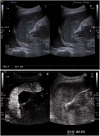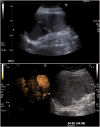Contrast-enhanced ultrasound of the spleen
- PMID: 27433274
- PMCID: PMC4760613
- DOI: 10.1177/1742271X15617214
Contrast-enhanced ultrasound of the spleen
Abstract
Abnormalities in the spleen are less common than in most other abdominal organs. However, they will be regularly encountered by ultrasound practitioners, who carefully evaluate the spleen in their abdominal ultrasound studies. Conventional grey scale and Doppler ultrasound are frequently unable to characterise focal splenic abnormalities; even when clinical and laboratory information is added to the ultrasound findings, it is often not possible to make a definite diagnosis. Contrast-enhanced ultrasound (CEUS) is easy to perform, inexpensive, safe and will usually provide valuable additional information about splenic abnormalities, allowing a definitive or short differential diagnosis to be made. It also identifies those lesions that may require further imaging or biopsy, from those that can be safely dismissed or followed with interval ultrasound imaging. CEUS is also indicated in confirming the nature of suspected accessory splenic tissue and in selected patients with abdominal trauma. This article describes the CEUS examination technique, summarises the indications for CEUS and provides guidance on interpretation of the CEUS findings in splenic ultrasound.
Keywords: Spleen; contrast microbubbles; ultrasound; ultrasound contrast.
Figures








Similar articles
-
Applications of Contrast-Enhanced Ultrasound in Splenic Studies of Dogs and Cats.Animals (Basel). 2022 Aug 17;12(16):2104. doi: 10.3390/ani12162104. Animals (Basel). 2022. PMID: 36009694 Free PMC article. Review.
-
Various aspects of Contrast-enhanced Ultrasonography in splenic lesions - a pictorial essay.Med Ultrason. 2020 Sep 5;22(3):2521. doi: 10.11152/mu-2521. Med Ultrason. 2020. PMID: 32898207 Review.
-
A rare case of accessory spleen torsion in a child diagnosed by ultrasound (US) and contrast-enhanced ultrasound (CEUS).J Ultrasound. 2019 Mar;22(1):99-102. doi: 10.1007/s40477-019-00359-4. Epub 2019 Feb 13. J Ultrasound. 2019. PMID: 30758809 Free PMC article.
-
Contrast-enhanced ultrasound versus MS-CT in blunt abdominal trauma.Clin Hemorheol Microcirc. 2008;39(1-4):155-69. Clin Hemorheol Microcirc. 2008. PMID: 18503121
-
Diagnosis of congenital and acquired focal lesions in the neck, abdomen, and pelvis with contrast-enhanced ultrasound: a pictorial essay.Eur J Pediatr. 2018 Oct;177(10):1459-1470. doi: 10.1007/s00431-018-3197-8. Epub 2018 Jul 3. Eur J Pediatr. 2018. PMID: 29971555
Cited by
-
Diagnostic accuracy of contrast enhanced ultrasound in patients with blunt abdominal trauma presenting to the emergency department: a systematic review and meta-analysis.Sci Rep. 2017 Jun 30;7(1):4446. doi: 10.1038/s41598-017-04779-2. Sci Rep. 2017. PMID: 28667280 Free PMC article.
-
Hepatosplenic Cat Scratch Disease: Description of Two Cases Undergoing Contrast-Enhanced Ultrasound for Diagnosis and Follow-Up and Systematic Literature Review.SN Compr Clin Med. 2021;3(10):2154-2166. doi: 10.1007/s42399-021-00940-1. Epub 2021 Jun 15. SN Compr Clin Med. 2021. PMID: 34151189 Free PMC article. Review.
-
Contrast-enhanced Ultrasound as a Method of Splenic Injury Assessment.J Med Ultrasound. 2024 Sep 25;32(4):291-296. doi: 10.4103/jmu.jmu_33_24. eCollection 2024 Oct-Dec. J Med Ultrasound. 2024. PMID: 39801539 Free PMC article. Review.
-
Expanding Role of Contrast-Enhanced Ultrasound and Elastography in the Evaluation of Abdominal Pathologies in Children.Diagnostics (Basel). 2025 Jul 1;15(13):1680. doi: 10.3390/diagnostics15131680. Diagnostics (Basel). 2025. PMID: 40647679 Free PMC article. Review.
-
Use of contrast-enhanced ultrasound for assessment of nodular lymphoid hyperplasia (NLH) in canine spleen.BMC Vet Res. 2019 Jun 11;15(1):196. doi: 10.1186/s12917-019-1942-5. BMC Vet Res. 2019. PMID: 31185980 Free PMC article.
References
-
- Catalano O, Lobianco R, Sandomenico F, et al. Real-time contrast-enhanced ultrasound of the spleen: examination technique and preliminary clinical experience. Radiol Med 2003; 106: 338–356. - PubMed
-
- Goerg C, Schwerk WB, Goerg K. Sonography of focal lesions of the spleen. AJR Am J Roentgenol 1991; 156: 949–953. - PubMed
-
- Piscaglia F, Nolsøe C, Dietrich CF, et al. The EFSUMB guidelines and recommendations on the clinical practice of contrast enhanced ultrasound (CEUS): update 2011 on non-hepatic applications. Ultraschall Med 2012; 33: 33–59. - PubMed
-
- Piscaglia F, Bolondi L. The safety of Sonovue in abdominal applications: retrospective analysis of 23188 investigations. Ultrasound Med Biol 2006; 32: 1369–1375. - PubMed
-
- Lim AK, Patel N, Eckersley RJ, et al. Evidence for spleen-specific uptake of a microbubble contrast agent: a quantitative study in healthy volunteers 1. Radiology 2004; 231: 785–788. - PubMed
Publication types
LinkOut - more resources
Full Text Sources
Other Literature Sources
